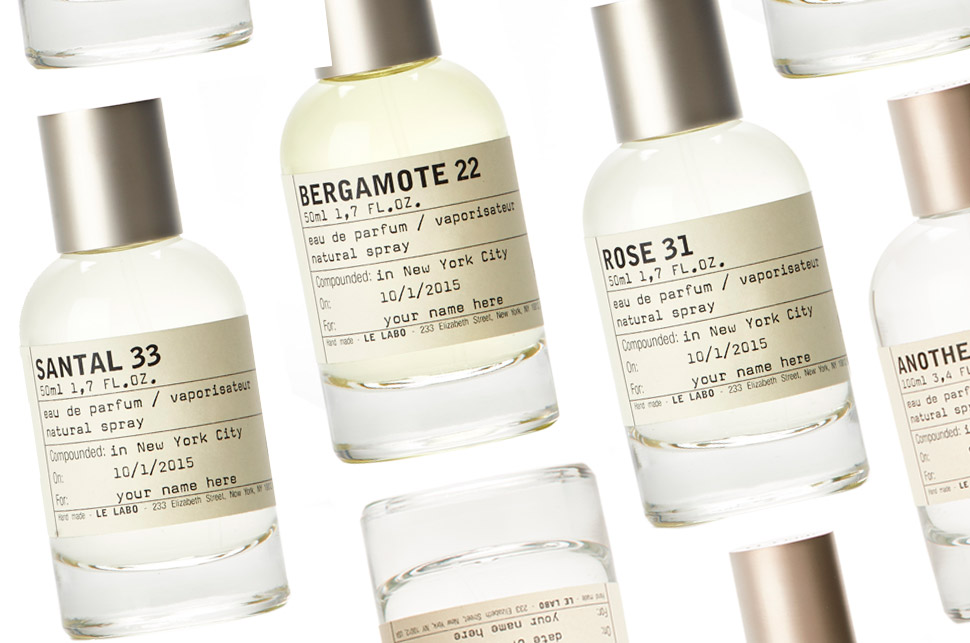For the past several years, it has been difficult for many city-dwellers from those in New York all the way to Singapore to avoid one particular scent: the distinctly musky, leathery, sandalwood-y aroma of Le Labo’s Santal 33. The 8-year old fragrance began, according to the New York Times, “as an antidote to mass-market scents.” After all, Le Labo – with its miniscule spending compared to the tens of millions of dollars that prestige brands allocate each year to marketing efforts, and an aversion to big-name celebrity endorsers – is, or is supposed to be, a niche venture.
Founded in 2006 in New York by Eddie Roschi and Fabrice Penot, fragrance veterans who met while working in the perfume division of Giorgio Armani, Le Labo takes a quieter approach to fragrances than the industry’s leaders. Mr. Penot told Forbes that they prefer to ” spend money on perfume” … and real estate, of course: Le Labo – now under the Estee Lauder umbrella – has vastly expanded its brick-and-mortar network (up from one New York City store in 2006 to 50-plus as of now), which stretches from Sydney to Kuwait to London to Houston.
Yet, while Santal 33 may have initially been intended to serve as an off-the-beaten path product in the large-scale, thoroughly-corporatized fragrance market, the $180-plus unisex fragrance has “ironically,” as the Times noted in 2015, “ended up, to the discerning nose, all over the place.”
It is “that perfume you smell everywhere,” the Times asserted, “the most spritzed perfume around,” per fashion site WhoWhatWear. British publication The Independent has called its success “reminiscent of the cult followings usually reserved for perfume icons like Chanel No. 5 and Yves Saint Laurent’s Opium.”
Others have pointed to the fragrance’s “distinctive blend,” its “unique scent,” and its “instantly recognizable aroma.” In other words: at least some portion of the consuming public associates the specific smell of Santal 33 with a specific brand: Le Labo. That is significant, as it means that the scent, itself, is capable of indicating the source of the product, which in many other instances is precisely what gives rise to trademark protections.
Yet, fragrances are not registrable as trademarks even if they are so well known that consumers “instantly” and infallibly link the scent to one brand in the same way as they link the word “Gucci” with a single brand. Unlike the Gucci name, which is subject to a wide variety of trademark protections across the globe, Le Labo’s Santal 33 scent enjoys no such protections.
The Le Labo name is subject to trademark registrations, and “Santal 33” likely maintains common law rights (in lieu of registrations), but the scent, itself, has no such rights.
That is not because smells are not protectable by way of trademark law – because they are. For instance, just last year, Play-Doh maker Hasbro was awarded a trademark registration by the U.S. Patent and Trademark Office (“USPTO”) for the “distinctive smell” of its famous modeling compound. To be exact, Hasbro’s trademark extends to “the scent of a sweet, slightly musky, vanilla fragrance, with slight overtones of cherry, combined with the smell of a salted, wheat-based dough” for use in connection with “toy modeling compounds.”
What is the difference between Play-Doh (and other federally-protected scents) and fragrances? For the latter, the scent is essential to the purpose of a fragrance product, making it functional, and thereby, ineligible for registration with the USPTO (as functionality is a bar to registration). This remains true even if the scent has acquired distinctiveness – or in other words: consumers have come to link it to a single source.
The functionality doctrine – which aims to prevent the inhibition of legitimate competition by allowing a producer to control a useful product feature – “makes sense in theory,” Franco Galbo wrote for IP Watchdog. However, “it is silly to think that scents – such as Chanel No. 5, arguably the world’s most iconic perfume and one that has held beauty industry [and consumer] attention since its creation in 1921 – are ineligible for protection despite widespread consumer recognition” simply because they serve a function, i.e., making the wearer smell better.
More than that, the result of the application of the functionality doctrine to fragrances is “ironic,” he says, because it means that “a scent as famous and recognizable as Chanel No. 5 is ineligible for trademark protection, leaving open the possibility of copycat products without the possibility of legal recourse.” (While trademark protections are squarely left off of the table as a result of the non-functionality requirement, perfume-makers are not entirely without recourse. Both patent law and trade secret law provides avenues for those seeking to protect their creations).
This is significant, according to University of Southern California Law professor Charles Cronin, given that “the inexorable consolidation in the fragrance manufacturing industry over the past century has made the remaining fragrance houses more vulnerable to misappropriation of their intellectual property, particularly of fragrance formulas that they develop at significant expense.”











